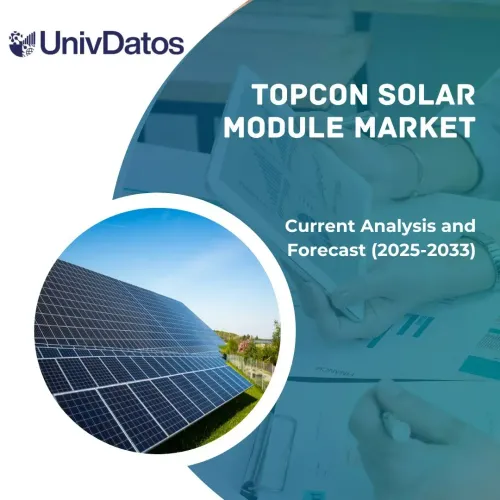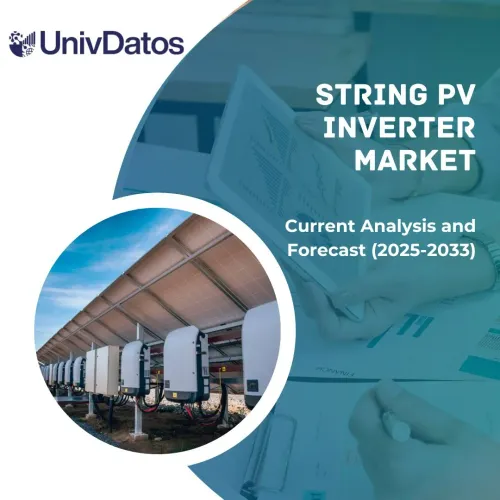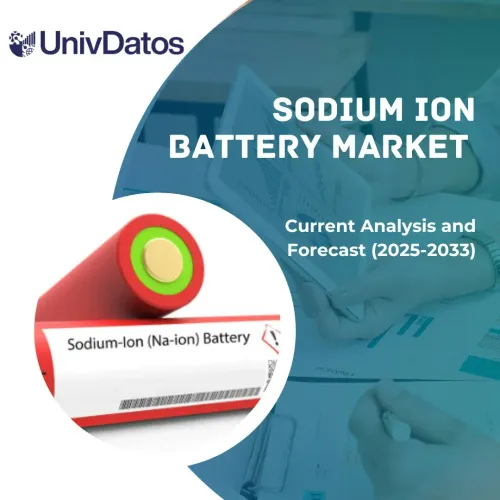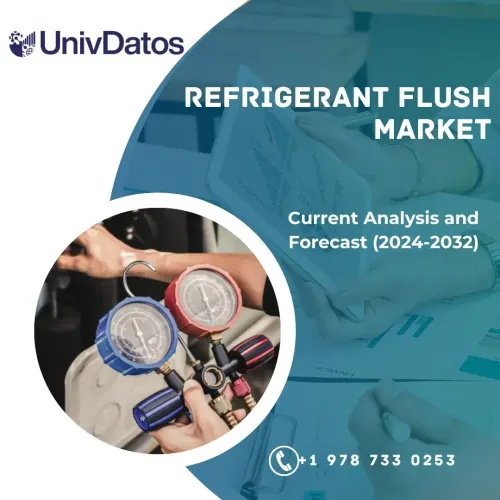中東ソーラーウィンドウ市場:現状分析と予測(2023~2030年)
エンドユーザー[商業ビル、その他(農業、自動車など)]の重視;用途(スカイライト、カーテンウォールとファサード、その他);および地域/国
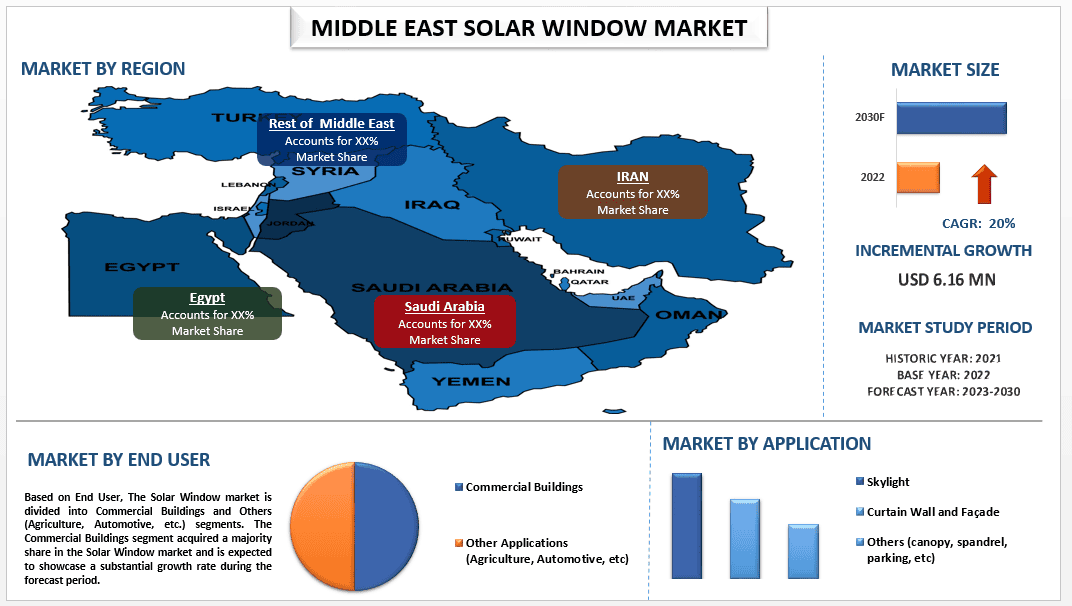
中東ソーラーウィンドウ市場は2022年に616万ドルと評価され、予測期間中に20%のCAGRで成長すると予想されています。これは主に、世界的な気候変動政策に対応するために、よりクリーンな再生可能エネルギーを促進するための政府のプログラムとインセンティブによるものです。ソーラーウィンドウは、太陽光から電気を生成するために太陽電池または他の光起電材料を組み込んだ窓です。セルは通常透明であり、光を透過させながら窓を透明に保つことができます。気候変動への懸念と炭素排出量の削減の必要性が、中東におけるソーラーウィンドウ市場の需要を増大させています。
市場で活動している主要プレーヤーには、Ubiquitous Energy Inc.、SolarWindow Technologies, Inc.、ClearVue Technologies Limited、PHYSEE Group B.V.、EnergyGlass Limited、Glass to Power SpA、Brite Hellas S.A.、Onyx Solar Group LLC、Polysolar Ltd、およびNEXT Energy Technologiesがあります。
レポートに提示される洞察
「エンドユーザーのうち、商業ビルセグメントが2022年に市場の支配的なシェアを占めました」
エンドユーザーに基づくと、ソーラーウィンドウ市場は商業ビルと他のセグメントに分けられます。商業ビルセグメントは、ソーラーウィンドウ市場で大多数のシェアを獲得し、予測期間中に大幅な成長率を示すと予想されています。これは、中東地域が、経済的および環境的考慮事項の両方に対応する要因の合流により、商業ビルにおけるソーラーウィンドウの需要の増加を目の当たりにしているためです。
「用途のうち、カーテンウォールとファサードセグメントが2022年に市場の支配的なシェアを占めました」
用途に基づいて、ソーラーウィンドウ市場はスカイライト、カーテンウォールとファサード、およびその他のセグメントに分類されます。ソーラーウィンドウは建物のどの部分にも適用できますが、市場はまだ開発段階にあるため、現在の主な用途分野はスカイライトとカーテンウォールとファサードです。
中東ソーラーウィンドウ市場レポートの範囲

「UAEは2022年に中東ソーラーウィンドウ市場の主要なシェアを占めています」
UAEは、エネルギーミックスを多様化し、炭素排出量を削減するための取り組みの一環として、野心的な再生可能エネルギー目標を設定しました。これらの目標は、持続可能な建築慣行の一環として、ソーラーウィンドウのような革新的な技術の採用を促進する可能性があります。また、UAEの気候は十分な日照を特徴としており、太陽エネルギー発電に最適な場所となっています。太陽光発電技術は、エネルギー生産のための太陽光の利用可能性を考慮すると、この国で特に有利となる可能性があります。UAE政府が、建物における太陽光発電技術の使用を促進するインセンティブ、補助金、または政策を導入すれば、ソーラーウィンドウ市場の成長を促進する可能性があります。
このレポートを購入する理由:
- この調査には、認証された主要な業界専門家によって検証された市場規模と予測分析が含まれています。
- このレポートは、業界全体のパフォーマンスを迅速にレビューします。
- このレポートは、主要なビジネス財務、製品ポートフォリオ、拡張戦略、および最近の動向に重点を置いて、著名な業界ピアの徹底的な分析を提示します。
- 業界で蔓延しているドライバー、制約、主要なトレンド、および機会の詳細な調査。
- この調査は、さまざまなセグメントにわたる市場を包括的にカバーしています。
- 業界の詳細な国レベル分析。
カスタマイズオプション:
中東ソーラーウィンドウ市場は、要件または他の市場セグメントごとにさらにカスタマイズできます。これとは別に、UMIは、お客様が独自のビジネスニーズを持っている可能性があることを理解しています。そのため、お客様の要件に完全に適合するレポートを入手するために、お気軽にご連絡ください。
目次
中東ソーラーウィンドウ市場分析の調査方法(2023~2030年)
中東ソーラーウィンドウ市場の過去の市場を分析し、現在の市場を推定し、将来の市場を予測することは、主要国におけるソーラーウィンドウの採用を作成および分析するために行われた3つの主要なステップでした。過去の市場規模を収集し、現在の市場規模を推定するために、徹底的な二次調査が実施されました。次に、これらの洞察を検証するために、多数の調査結果と仮定が考慮されました。さらに、中東ソーラーウィンドウ市場のバリューチェーン全体の業界専門家との徹底的な一次インタビューも実施されました。一次インタビューによる市場規模の仮定と検証の後、トップダウン/ボトムアップアプローチを採用して、完全な市場規模を予測しました。その後、市場の細分化とデータの三角測量手法を採用して、業界のセグメントおよびサブセグメントの市場規模を推定および分析しました。詳細な方法論は以下に説明されています。
過去の市場規模の分析
ステップ1:二次資料の詳細な調査:
中東ソーラーウィンドウ市場の過去の市場規模を取得するために、詳細な二次調査が実施されました。これには、次のような企業の内部資料が含まれます。年次報告書と財務諸表、パフォーマンスプレゼンテーション、プレスリリースなど、および、以下を含む外部資料ジャーナル、ニュースと記事、政府出版物、競合他社の出版物、セクターレポート、サードパーティデータベース、およびその他の信頼できる出版物。
ステップ2:市場セグメンテーション:
中東ソーラーウィンドウ市場の過去の市場規模を取得した後、主要国のさまざまなセグメントとサブセグメントの過去の市場洞察とシェアを収集するために、詳細な二次分析を実施しました。主要なセグメントには、エンドユーザーと用途が含まれます。さらに、その国におけるテストモデルの全体的な採用を評価するために、国レベルの分析が実施されました。
ステップ3:要因分析:
さまざまなセグメントとサブセグメントの過去の市場規模を取得した後、詳細な要因分析を実施して、中東ソーラーウィンドウ市場の現在の市場規模を推定しました。さらに、中東ソーラーウィンドウ市場のエンドユーザーや用途などの依存変数と独立変数を使用して、要因分析を実施しました。世界中の中東ソーラーウィンドウ市場セクターにおける主要なパートナーシップ、合併と買収、事業拡大、製品発売を考慮して、需要と供給側のシナリオについて徹底的な分析が実施されました。
現在の市場規模の推定と予測
現在の市場規模の算出:上記の3つのステップからの実用的な洞察に基づいて、現在の市場規模、中東ソーラーウィンドウ市場の主要プレーヤー、およびセグメントの市場シェアに到達しました。必要なすべての割合シェア分割と市場内訳は、上記で言及した二次アプローチを使用して決定され、一次インタビューを通じて検証されました。
推定と予測:市場の推定と予測については、ステークホルダーが利用できるドライバーとトレンド、制約、機会など、さまざまな要因に加重値を割り当てました。これらの要因を分析した後、関連する予測手法、つまりトップダウン/ボトムアップアプローチを適用して、主要市場全体のさまざまなセグメントとサブセグメントについて、2030年の市場予測に到達しました。市場規模を推定するために採用された調査方法には、以下が含まれます。
- 収益(米ドル)の観点からの業界の市場規模と、主要市場全体での中東ソーラーウィンドウ市場の採用率
- 市場セグメントおよびサブセグメントのすべての割合シェア、分割、および内訳
- 提供される技術の観点から見た、中東ソーラーウィンドウ市場の主要プレーヤー。また、これらのプレーヤーが急成長する市場で競争するために採用した成長戦略
市場規模とシェアの検証
一次調査:主要国全体で、トップレベルの幹部(CXO/VP、営業本部長、マーケティング本部長、事業本部長、地域本部長、カントリーヘッドなど)を含むキーオピニオンリーダー(KOL)との詳細なインタビューを実施。一次調査の結果を要約し、提示された仮説を証明するために統計分析を実行。一次調査からのインプットを二次調査の結果と統合し、情報を実用的なインサイトに変換。
異なる地域における主要参加者の内訳
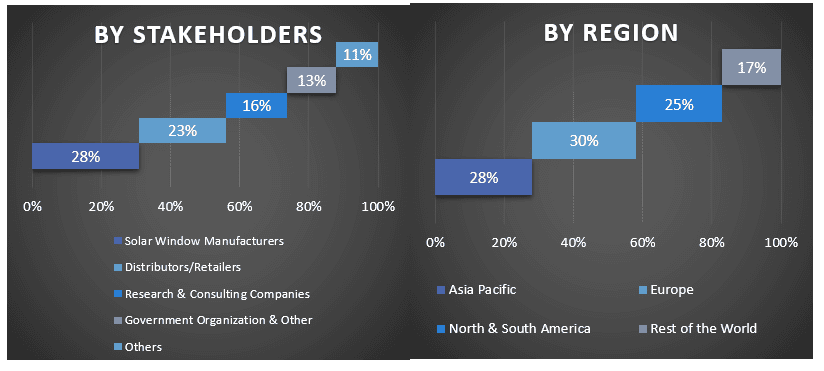
市場エンジニアリング
データ三角測量技術を採用し、市場全体の推定を完了し、中東ソーラーウィンドウ市場の各セグメントおよびサブセグメントについて正確な統計数値を算出しました。エンドユーザー、用途の分野における様々なパラメータとトレンドを調査した後、データはいくつかのセグメントとサブセグメントに分割されました。
中東ソーラーウィンドウ市場調査の主な目的
本調査では、中東ソーラーウィンドウ市場の現在および将来の市場動向を特定しました。投資家は、本調査で実施された定性的および定量的な分析に基づいて、投資判断を行うための戦略的インサイトを得ることができます。現在および将来の市場動向は、国レベルでの市場全体の魅力を決定し、産業参加者が未開拓市場を開拓し、先発者利益を享受するためのプラットフォームを提供します。調査の他の定量的な目標には以下が含まれます:
- 中東ソーラーウィンドウ市場の現在の市場規模と予測市場規模を金額(USD)で分析します。また、さまざまなセグメントとサブセグメントの現在の市場規模と予測市場規模を分析します
- 調査におけるセグメントには、エンドユーザーと用途の分野が含まれます。
- 中東ソーラーウィンドウ業界の規制枠組みの定義と分析
- さまざまな仲介業者の存在に関連するバリューチェーンを分析するとともに、業界の顧客および競合他社の行動を分析する
- 主要国における中東ソーラーウィンドウ市場の現在の市場規模と予測市場規模を分析する
- 本レポートで調査した主要国には、アジア太平洋、ヨーロッパ、北米、南米、およびその他の地域が含まれます
- 中東ソーラーウィンドウ市場の企業プロファイルと、急速に成長する市場で持続するための市場プレーヤーが採用した成長戦略
- 業界の詳細な国レベル分析
関連 レポート
この商品を購入したお客様はこれも購入しました

